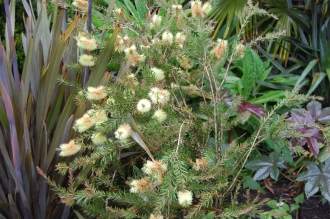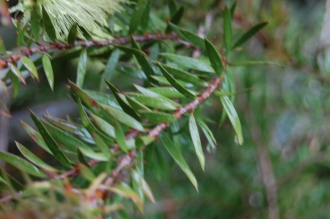Position: Full sun to partial shade
Soil: Moist, well drained
Flowering period: Summer
Eventual Height: 2.5m
Eventual Spread: 2m
Hardiness: 8a, 8b, 9a, 9b, 10a, 10b
Family: Myrtaceae
Callistemon viridiflorus is an evergreen shrub or tree with an open habit. Its grey/ green leaves are linear to lanceolate with entire margins, up t0 35mm long and are aromatic when crushed. Its branches develop rough white bark as it matures. It bears bottle brush like spikes of hermaphrodite flowers with enlarged cream/ green stamens arranged radially around the tips of the flowering stems and are up to 7.5cm long. Its fruit are dark, tightly spaced small fruit.
Callistemon viridiflorus, commonly known as the Green Bottlebrush, is native to Tasmania. In its native habitat it grows in mountain rain forests.
The etymological root of the binomial name Callistemon is derived from the ancient Greek Kalli meaning ‘beautiful’ and stamen the pollen producing part of a flower. Viridiflorus is derived from the Latin viridis meaning ‘green and flora meaning ‘flower’.
The Landscape architect may find Callistemon viridiflorus useful as an attractive medium sized evergreen shrub with showy green flowers. A warm sheltered location will ensure this plant flowers prolifically. Once established this shrub is drought tollerant. This shrub is not attractive to deer or rabbits.
Ecologically, Callistemon citrinus flowers are attractive to pollinating insects.
Callistemon viridiflorus prefers moist, fertile, well-drained soils. It tolerates most pH of soil.
Callistemon viridiflorus requires little to no maintenance, dead or damaged material may be removed after flowering.







